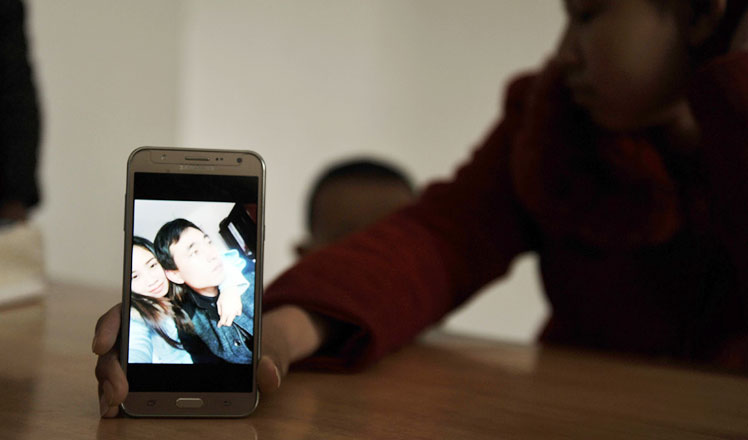Escaping from a scroll
Updated: 2016-04-27 08:27
By Erik Nilsson(China Daily)
|
|||||||||
It took over 400 ethnic Tibetan, Tu, Mongolian and Han scholars from the Tibet autonomous region, and Gansu, Qinghai, Sichuan and Yunnan provinces 27 years to put the final strokes on the horizontally protracted, 2.5-meter-high masterpiece.
The astonishing artwork renders a cosmovision that can perhaps be thought of a very different take than Stephen Hawking's on a "brief history of time", not only in content but also in presentation.
It's a recitation of everything-abridged, despite its great length.
The picture story begins with the universe's emergence. It soon after shows early hominids discovering tools, fire and hunting. It chronicles biological, technological and societal evolution to modern man, amid the context of the spiritual advancement of Buddhism, while triumphantly declaring Tibetan medicine to be 3,800 years old.
Our legacy literally unfolds across the scroll to show animals roving wild and then pacing in pens, while humans move from mud huts to brick buildings. The saga's final punctuation point is the present period.
The floor's only other display is The Great Book-a 1.5-ton copy of the 156-chapter medical code Tibetan intellectual Yuthok Yonten Gonpo compiled between 773 and 783.
The compendium's most massive edition is 2.5 meters high and over 2 meters wide.
Silver, pearl and coral powders artistically present 2.5 million articles over 490 pages that took craftspeople and calligraphers more than four years to complete.
Its superlative character may be better recognized if it weren't juxtaposed against The Great Scroll.
Ultimately, and seemingly unintentionally, the Tibetan Medicine Museum of China is an art museum as well as an institution elucidating traditional healing.
Yet it remains relatively unknown, despite containing the Guinness World Record-setting scroll. That is, the artwork we discovered you can lose yourself in-and your way out of.
The magnificent masterpiece isn't the museum's only painting.
The first floor is full of anatomy diagrams that signage claims have been used for two millennia.
That said, some depict anthropomorphic creatures with, for instance, goat heads and snake bodies being swallowed by fish. (Hopefully, they're recognized as outdated.)
Diseases are depicted as sword-fights with snakes, stabbings by blades and stings by scorpions. (Figuratively, we trust.)
The diagrams about behavior, skeletal systems and poisoning also display instruments for bloodletting, surgery and autopsy. Implements' replicas are exhibited alongside.
It's a shame we had to dash to escape the scroll in particular and the museum in general.
It's the kind of place where you could get lost for a day-ideally, on purpose.
- EU pledges 20 mln euros to nuclear safety fund
- DPRK seems set to launch Musudan ballistic missile
- Austria far right freezes out coalition in presidency race
- Chernobyl's 30th anniversary: Living under radiation
- S. Korea denounces DPRK's missile test
- Saudi-led coalition says kills more than 800 al-Qaida militants in Yemen

 30th anniversary of the Chernobyl nuclear disaster marked
30th anniversary of the Chernobyl nuclear disaster marked
 Shanghai unveils Disney-themed plane and station
Shanghai unveils Disney-themed plane and station
 Hebei's poverty-stricken village gets new look after Xi's visit
Hebei's poverty-stricken village gets new look after Xi's visit
 Cooks get creative with spring food exhibition in central China
Cooks get creative with spring food exhibition in central China
 The world in photos: April 18- April 24
The world in photos: April 18- April 24
 People have fun in pillow fight held in Kiev
People have fun in pillow fight held in Kiev
 Laotian wives in East China's Anhui province
Laotian wives in East China's Anhui province
 Couples get married in their 'birthday suit'
Couples get married in their 'birthday suit'
Most Viewed
Editor's Picks

|

|

|

|

|

|
Today's Top News
Liang avoids jail in shooting death
China's finance minister addresses ratings downgrade
Duke alumni visit Chinese Embassy
Marriott unlikely to top Anbang offer for Starwood: Observers
Chinese biopharma debuts on Nasdaq
What ends Jeb Bush's White House hopes
Investigation for Nicolas's campaign
Will US-ASEAN meeting be good for region?
US Weekly

|

|









